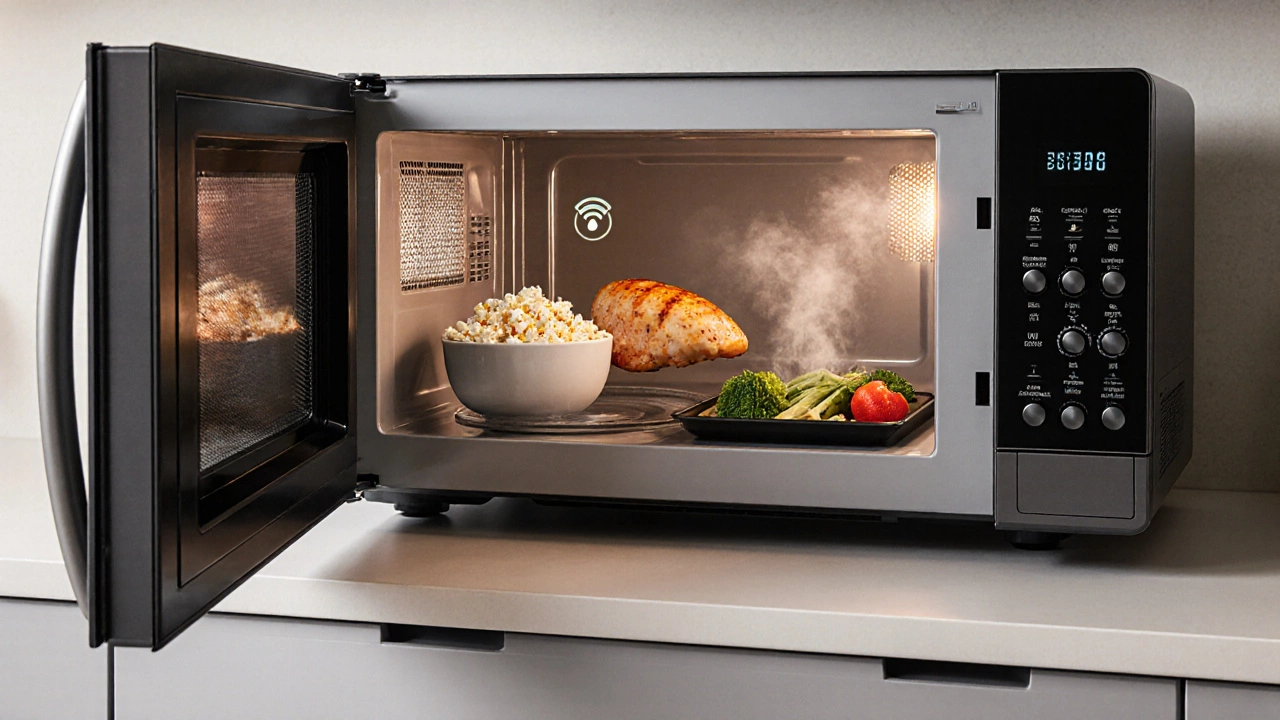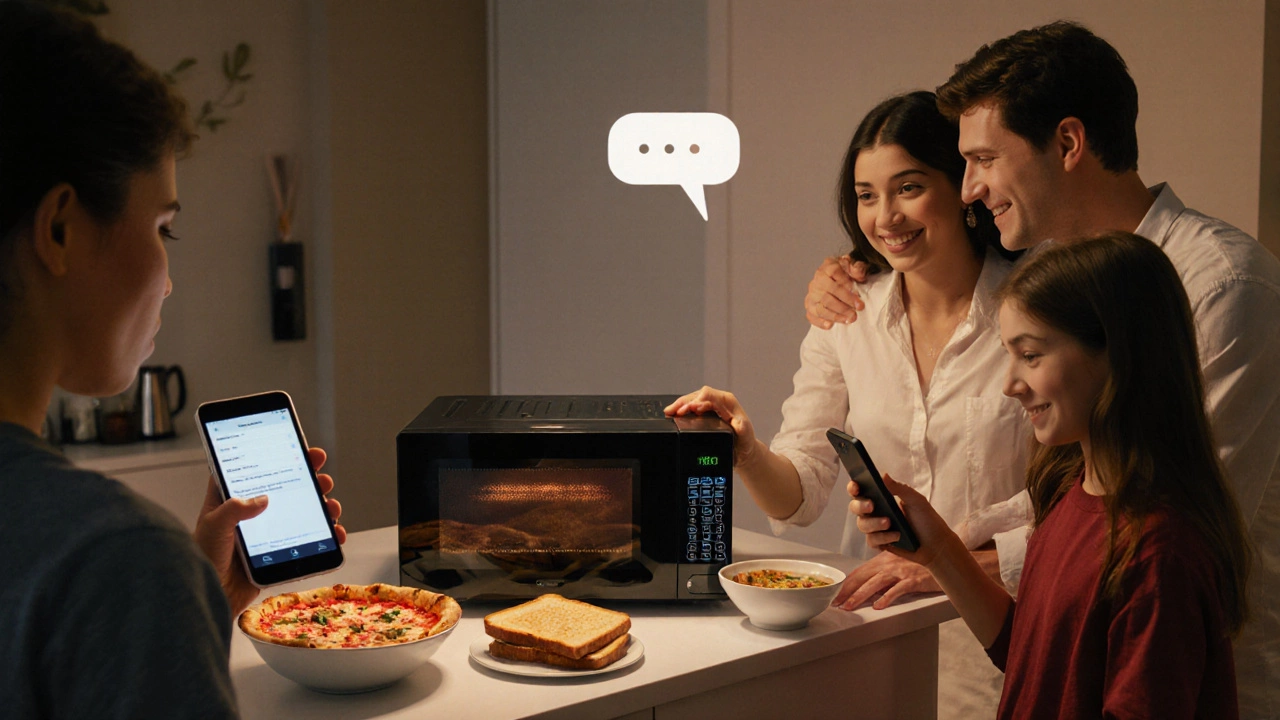Microwave Size & Feature Calculator
Your Cooking Profile
Recommended Microwave
Capacity Recommendation
Must-Have Features
Budget Range
Based on your selections, the ideal microwave should have at least watts and include features.
Calculating your perfect microwave...
Finding the right microwave can feel like a grocery‑store maze: endless models, confusing specs, and a price tag that jumps around. The good news? You don’t need a gadget‑guru degree to pick one that fits your kitchen, cooking style, and budget. Below is a step‑by‑step guide that walks you through the must‑know features, the different types on the market, and the questions to ask before you click “add to cart.”
Quick Takeaways
- Identify the primary cooking tasks you need - reheating, defrosting, baking, or grilling.
- Match capacity (cubic feet) to your family size and countertop space.
- Look for inverter or sensor cooking for even heat and energy savings.
- Set a realistic budget: $100‑$200 for basic models, $300‑$600 for convection or smart units.
- Check warranty length and customer‑service reputation before purchase.
Understanding Your Kitchen Needs
First, think about how you actually use a microwave. If you mostly reheat leftovers, a basic 700‑W unit with a simple keypad is enough. If you enjoy “microwave‑baking” - making pizza, casseroles, or even a quick loaf - you’ll benefit from higher wattage and additional cooking modes.
Family size matters too. A single‑person household can get away with a 0.7‑cubic‑foot interior, while a family of four should aim for at least 1.2cubicfeet. Measure the space on your countertop or built‑in slot; leave at least 2inches of clearance on all sides for ventilation.
Core Features to Compare
Below are the features that truly separate a decent microwave from a great one. Each feature is explained with a real‑world example so you can see the impact on everyday cooking.
- Inverter technology - Unlike traditional on/off magnetron cycles, inverter microwaves adjust power continuously, delivering more even heating. You’ll notice fewer cold spots in thick chicken breasts.
- Sensor cooking - Built‑in humidity sensors automatically adjust time and power. Great for popcorn or frozen veggies - just press “Sensor Cook” and walk away.
- Turntable - A rotating glass tray spreads microwaves evenly. If you prefer a flatbed design (for taller dishes), make sure the model offers a “stirrer” fan instead.
- Grill function - Adds a top‑heat element for browning and crisping. Ideal for making toasted sandwiches or finishing a lasagna.
- Steam cooking - Injects moisture while heating, preserving nutrients in fish and vegetables.
- Energy efficiency - Look for the ENERGY STAR label. Inverter models can be up to 30% more efficient than older units.
- Wattage - Higher watts mean faster cooking. 900‑W is a sweet spot for most households; 1200‑W is best for serious bakers.
- Capacity - Measured in cubic feet. Larger capacity lets you heat full‐size pizza trays or roasting pans.
- Control panel - Touchscreen panels look slick but can be harder to clean than mechanical dials. Choose what feels comfortable for you.
- Child lock - Prevents accidental starts. Essential for families with young kids.
- Smart connectivity - Wi‑Fi enabled models let you start cooking from a phone app or voice assistant.
- Auto cook presets - One‑button programs for popcorn, pizza, frozen meals, etc.
- Interior lighting - Bright LED lights make it easier to see food without opening the door.

Types of Microwaves
Not all microwaves are created equal. The three main categories are:
- Standard microwave - Basic on/off magnetron, usually the cheapest option.
- Convection microwave - Adds a convection fan and heating element, enabling baking and roasting.
- Smart microwave - Integrates Wi‑Fi, voice control, and sometimes camera interiors for remote monitoring.
Choosing between them depends on how much you want to expand your cooking repertoire. If you rarely bake, a standard unit saves money and space. If you love crisp crusts or want to replace a small toaster oven, go for a convection model. For tech‑savvy households that love app‑based control, a smart microwave is the way to go.
How to Evaluate Specifications
Grab the spec sheet (or product page) and run through this quick checklist:
- Power (Wattage): 700W = basic; 900‑1000W = median; 1200W = high‑performance.
- Capacity: 0.5‑0.7cuft = single‑serve; 0.9‑1.2cuft = average family; 1.5cuft+ = large‑batch cooking.
- Cooking modes: Count how many you need - sensor, grill, steam, convection.
- Control type: Touchscreen vs. rotary dial vs. keypad.
- Dimensions: Measure your countertop width, height, and depth.
- Warranty: Look for at least 1year parts & labor; 2‑year coverage is a plus.
When you see a spec like “Inverter 1000W, 1.2cuft, 5‑speed fan, Wi‑Fi,” you can immediately gauge that the unit targets tech‑oriented cooks who need a bit more power and flexibility.
Budget and Energy Considerations
Price ranges in 2025 are fairly stable:
- Basic models: $80‑$150.
- Mid‑range (inverter, sensor, 0.9‑1.2cuft): $200‑$350.
- High‑end (convection, smart, 1.5cuft+): $400‑$700.
Factor in operating cost. Inverter microwaves, while slightly pricier upfront, shave minutes off cooking time and reduce electricity usage. Over a typical 5‑year lifespan, the energy savings often offset the extra $50‑$100 you paid initially.

Installation and Space Planning
Most countertop microwaves just sit on the counter, but built‑in models require a cutout. Measure the width, depth, and vent clearance. Remember to leave a few inches behind for airflow; a cramped microwave can overheat and shorten its life.
If you opt for a built‑in convection microwave, check the ventilation requirements - many need a dedicated vent to the exterior or a filtered recirculating system.
Checklist Before Purchase
- Define primary cooking tasks (reheat, bake, grill, steam).
- Confirm countertop or built‑in dimensions.
- Choose capacity that fits your typical dish size.
- Prefer inverter or sensor technology for even heating.
- Decide if you need extra functions (grill, steam, convection, smart).
- Set a budget and compare at least three models within that range.
- Read recent user reviews focusing on durability and customer service.
- Check warranty length and availability of replacement parts.
Frequently Asked Questions
What wattage should I look for in a microwave?
For most households, 900‑1000W provides a good balance of speed and energy use. If you plan to bake or roast, consider 1200W.
Is a convection microwave worth the extra cost?
Yes, if you want to replace a small oven or toaster oven. Convection adds true baking and browning, letting you make crispy pizza and roasted veggies without a separate appliance.
Do smart microwaves actually save time?
Convenience is the main benefit - you can start cooking from your phone or voice assistant. Some models also store cooking histories to suggest optimal times, which can shave a minute or two off repetitive tasks.
How often should I clean the interior?
Wipe down the cavity after each use if you notice splatters. A deep clean with a mild vinegar‑water solution once a month prevents odor buildup.
Can I use metal cookware in a microwave?
Never place solid metal inside a standard microwave - it sparks and can damage the unit. Some convection models allow metal trays only when the convection mode is active, but check the manual first.
The bottom line is simple: match the microwave’s power, capacity, and extra features to the way you cook, and you’ll avoid paying for technology you never use. Armed with this guide, you can walk into any store or browse online with confidence, knowing exactly which specs matter and why. Happy microwaving!

